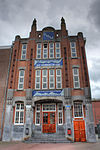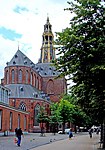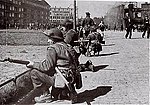Oosterkerk, Groningen
20th-century churches in the NetherlandsBrick ExpressionismBuildings and structures in Groningen (city)Churches in Groningen (province)Reformed church buildings in the Netherlands ... and 2 more
Religious buildings and structures completed in 1929Rijksmonuments in Groningen (province)

The Oosterkerk (English: Eastern Church) is a reformed church from 1929 in the Dutch city of Groningen. It is located in the Oosterparkbuurt, on the corner of the E. Thomassen à Thuessinklaan and the S.S. Rosensteinlaan.
Excerpt from the Wikipedia article Oosterkerk, Groningen (License: CC BY-SA 3.0, Authors, Images).Oosterkerk, Groningen
S.S. Rosensteinlaan, Groningen Oude wijken
Geographical coordinates (GPS) Address Website External links Nearby Places Show on map
Geographical coordinates (GPS)
| Latitude | Longitude |
|---|---|
| N 53.226666666667 ° | E 6.5725 ° |
Address
Oosterkerk
S.S. Rosensteinlaan
9713 AT Groningen, Oude wijken
Groningen, Netherlands
Open on Google Maps











